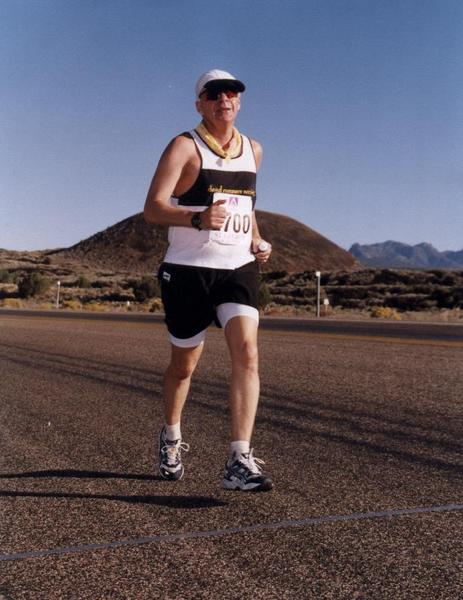
Official race picture,
about mile seven
| Neologistics→ Running → St. George 2000 |

Official race picture,
about
mile seven
Many moons ago I surmised there is one factor within my power to change that would improve my running performance: to lose some weight!
Therefore, on the morning of Monday, May 15, when I officially launched my training for St. George marathon, I weighed in at a horrendous high of 190.8 pounds, and proceeded to concentrate my efforts on shedding some blubber, while building mileage.
Ten weeks later, after numerous consecutive 50-mile-plus training weeks, I weighed in at exactly 180.8, leaving me rightly proud of my progress. However, it didn't last, as a week of being out of town and not running at all was a catalyst to the bottom dropping out of my program. I never did get anywhere near that plateau again.
Strike one!
The last four to six weeks before the marathon both my feet began to bother me. I've been experiencing uncomfortable swelling around the balls of my feet. I tried metatarsal pads. It cost me $6 to find out they only exacerbate the problem.
Strike two!
Fortunately, I've been able to do my long runs slowly, but hard, short runs cause problems afterward.
And so it was that when I weighed in last Friday morning, as we were getting ready to drive to St. George, the scale said 189.0, over 21 pounds heavier than the first time I ran the race in 1997. Poo. A net loss of 1.8 pounds since May doesn't count for much. Other than that, I felt well and ready.
We left home at 6:04 AM, on a beautiful, warm day. The first adventure of the trip occurred when we took a potty break at a McDonald's. I walked in and found only stalls, so I used one. As I was easing nature, someone else entered. Suddenly I thought to myself -- uh-oh! An inner voice told me something was wrong. I hurried to finish and get out. Yup, I'd walked into and used the ladies room. Oops. Fortunately, it was my wife who came in after me. Apparently no one noticed, so I avoided being arrested and hauled off to jail as a peeping Tom pervert.
Was this an omen of things to come?
We drove to St. George when we came the previous time. At that time we drove up through Las Vegas, since we were in no rush. This time I wanted to take the fastest route, so I pulled instructions off Mapquest that routed me through Page, AZ, then west, and ultimately through Zion State Park.
What the Mapquest instructions don't tell you (and neither does a road map) is that it costs $20 just to drive the 12 miles through Zion State Park. The alternative is to turn around, backtrack, and add about ninety minutes to your trip. I didn't realize this until I got right up to the gate.
The fee is good for seven days, the drive is beautiful, and yes, the money goes to help maintain the national park, but frankly I was too annoyed by the unexpected hit to enjoy it much. Twenty bucks is just too much to have to pay for someone who is merely passing through.
Our motel, one block off the highway exit, and within walking distance of the race headquarters, finish line and bus pickup, couldn't have been easier to find. It was also clean, functional, and reasonably priced, in addition to which we got an additional $8 per night AAA discount. Perfect.
The total drive time was only 7:45, and with another half hour to check in, get our stuff in, and drive to the Expo, we were still there by 3:20 PM, much earlier than anticipated. Utah time is an hour later than both Arizona and Nevada.
We arrived in time to pick up my race packet, which included swapping the number of my personal ChampionChip, to be used for the first time, for the one issued to me, then take a quick look around, and still make it with time to spare to the clinic by Runners' World columnist Ed Eyestone, who is from Utah, currently a track coach at BYU.
Eyestone is younger, smaller, and funnier than I imagined. I guess the beard he wears in the picture accompanying his column makes him look older and meaner.
He discussed nothing technical, which was fine with me. I was in a mood to be entertained. He told motivational stories about his two experiences as an Olympic marathoner, and about trying to become an All-American in his freshman year of college, which didn't happen, but there was a point to his story about the great effort he put forth. He even sang a running song he'd written, accompanying himself on the guitar, and rather well at that.
The Expo itself was nothing special -- the same as most others -- except it's always fun to walk around them, mostly to see other runners, especially to see the T-shirts they are wearing, and to look for familiar faces. I wore my blue long-sleeve DRS T-shirt in hopes of attracting some inquiries. It worked, as I met a woman who knows two Dead Runners I know personally. But I found no Penguins.
I've concluded over the last year that I'm better off eating little the day before a race. A big meal doesn't have time to digest and pass out of my system between evening and early morning, and promises to be the source of urgent and highly unpleasant potty problems on the road.
Nonetheless, it's become a tradition to indulge in a big carbohydrate-loading blast the night before a race. I've certainly engaged in quite a few myself. However, I recently remembered what I read six years ago in Galloway's Book on Running about eating the day before a race. Galloway is not a believer in carboloading, and experience has led me to feel the same.
Before my first race ever, a 10K, I followed Galloway's recommended regimen with such assiduous alacrity you would have thought I was preparing for the Olympic marathon, and I certainly benefitted from doing so.
Therefore, Friday night we did attend the official pastafest, because it was convenient and cheap, though not exactly good, but I limited myself to a single helping, with some salad, and ate no desert. Back at the motel I popped a few almonds. In this regard I did well.
My pre-race preparations have become like a priestly ritual -- laying everything out just so. Usually I make a list of what to do, and the order to do it. This time I didn't bother. Instead I just laid my stuff in one heap, presuming I'd get it all right in the morning. I did, and saved myself both time and anguish.
As the last thing before turning in, I made contact with local running hero Craig Davidson's wife Irene, and arranged to hitch a ride to the busses in the morning. When I pulled the covers up around my ears it was 8:02 PM -- only 7:02 by the Phoenix time my body was still on.
Because I knew what to expect of myself this marathon, and because I remember the course well, I didn't fret over it. As a result, I slept well. At 3:45 AM I was brought to life by a wakeup call, and got up feeling thoroughly rested and ready for the day.
When I stepped outside I found the temperature to be quite comfortable. I brought no tights. The warmup jacket I wore was entirely adequate, and useful to have for the sake of its pockets.
It didn't take long to get ready. In the past I've fussed with every detail. This day I gave the most attention to my feet. Breaking the rule that one should never try something new on race day, I decided to wear two pair of socks in order to give the tender balls of my feet extra cushioning. I later regretted this.
First, I utilized the ultrarunners' technique of carefully duct-taping the areas of my feet where I've been known to get blisters in the past. Then I lubricated the edges lightly, and finally thoroughly covered my feet. I've recently started using Bag Balm, an ointment used on cow udders, rather than Vaseline or Body Glide, which seems to work well.
Over my feet I put first a thin pair of running socks that I rarely wear, because I don't care for thin socks, then my SmartWool cushioned running socks, and of course my Asics Gel Foundations stuffed with the custom orthotics I wear daily.
Because of the anticipated temperature, I opted to do the whole run in just my DRS singlet, and I used my RaceReady shorts with pockets, in which I stored ID and a pillbox of Succeed! electrolyte capsules and Advil.
For some reason that went unexplained to the masses, Powerbar withdrew its sponsorship from St. George. Therefore, there was nothing provided at the aid stations except Gatorade, water, and at one late station some banana chunks. Persons who hoped to get chow on the road were out of luck.
I like Powerbars. I buy them in bulk and eat one for breakfast almost every day. However, I've found that I don't care for them as a performance fuel. They're too hard and dry to chew down when I'm also gasping for air.
So I came prepared with my own alternative. I've taken a liking to Hammer Gel, a highly digestible performance gel. It comes in 24-ounce jugs with an accompanying 5-ounce flask, which I filled to the brim and carried in my hand.
They opened up the breakfast room at the motel at 4:30 AM. By that time busses had already been loading and leaving for half an hour, but we had time. I really must have coffee in the morning. That, two glasses of orange juice, two pieces of raisin toast, and a handful of almonds proved to be all I needed to get me started for the morning.
A few minutes after 5:00 AM, Craig and Irene showed up, along with a half dozen Phoenix area runners. Another had also driven, and had a van, so everyone was able to ride comfortably.
I do hope Craig appreciates what a fine sport his wife is, to get up in the middle of the night and lug our grateful carcasses to the race start! And I hope she got several hours additional sleep afterward.
It took just a moment to locate a bus that needed only three more runners, so I hopped on and off we went, into the pitch dark early morning. The sight of the endless caravan of busses ahead of us as seen from the crests of hills was an enchanting sight. Rather than trying to doze, I kept entertained by conversing with the lady from Durango I sat next to. The results list only one woman from Durango, namely Laura Miller, age 45, who finished in 5:16.
This year the St. George marathon directors allowed more people in the race than in previous years. However, the only road to the start is no wider and no shorter. This resulted in a thornier traffic jam than I recall from 1997, as only three busses at a time could enter the start area, make a U-turn, pull up, and unload, before the next few could come up.
An unfortunate side effect of this was that many thoroughly hydrated and breakfasted people on busses behind us who were desperately in need of potties were bailing out on the side of the road and running ahead, causing safety problems, and slowing progress further for those who were still on the busses. Like they say, when you've gotta go, you've gotta go. Happily, these problems were overcome adroitly by the organizers, and everyone got there on time.
When I got off the bus it was 6:20 AM, and already quite crowded. The floodlights were blazing, motivational music blaring, race starter chanting, and runners stretching, guzzling, and gabbing. The lines to the abundant porta-potties were reasonable, and I was in and out in less than ten minutes. Happily, nature took its course in a timely manner this day, and I never had to worry about my churning insides during the race.
Before the start I saw no one I know. Though I'll usually chat with some stranger, for some reason, this time I didn't, except to explain the meaning of carpe viam to some laughing young women behind me.
These events would be more fun if I had more running friends, although I don't particularly like talking much when I'm trying to run for performance. I don't know how some people can pair up to run a marathon and jabber on and on the whole way. I see dozens of such groupings at every race.
Rigorous analysis of my training data over the last few months predicted a personal worst finishing time by at least twenty minutes. The numbers said I should run 5:10, if all things went normally, slower if they went badly, and if I had an exceptionally good race, I might break 5:00, which I made my target.
My secondary goal was to run the whole race, minus the shortest possible interruptions to drink. I've never actually accomplished this except for my first and second marathons.
This day I felt rested, enthusiastic, and ready to give it my best, so was optimistic for a good run, though a bit trepidatious regarding the heat: the prediction was for a high of ninety degrees.
The St. George course drops in elevation 2560 feet. It was much cooler at the start, where the elevation is 5240 feet, than it was earlier, back in the city. I was glad to keep my jacket until just a few minutes before the start, and to warm myself by one of the many bonfires, one of the more charming features of this race. Eventually, I made my way to the sign telling me where to stand, according to bib number. (I had the nice round number 2700.)
The St. George marathon starts with military precision. I couldn't read my Timex, which I synchronize regularly with an atomic clock, even with the Indiglo button pressed, but I doubt the race started any more than a few seconds late, if that. We heard the cheer go up at 6:40 for the wheelchair starters, and exactly five minutes later, we were off.
Sort of. As usual, there was a lurch forward by the crowd around me, followed by a putting on the brakes four or five feet later, and a great roar of amusement. Because this was a chip race, there was no rush to start running before we got there. I didn't note the clock as I crossed the start, and never did look at the clock time at the finish, so I didn't know the differential at the time. I later learned that I was 2:57 behind the clock time.
My plan was to hold back the first part of the race, and save strength for the downhills to come, some of which are quite steep. I've always gone out too fast in every race I've ever run.
Another tactic was to force myself to consume lots of water and Gatorade at every station, also to consume all the Hammer Gel, electrolyte capsules, and Advil I was carrying, on a precise schedule.
The Hammer Gel in a flask is a great idea. There's no fussing with ripping open, sucking on, and disposing of little baggies. Just pop the lid and take a swig. It's even easier than drinking from a water bottle.
My last goal was to run a negative split. This is something I have never come remotely close to accomplishing in a marathon. Even my PR was lopsided by 18 minutes, and if I crash and burn, the second half can take 25 or more minutes longer than the first half.
By now you're wondering how much of my ambition was realized. The answer is simple:
All of it! The details follow.
The race starts in darkness, but there is plenty of light from the floodlights. Within a mile it's light enough to see without problems. The early part of a marathon is unique for the sound, distinguished by the happy chatting and underlying constant throb of hundreds of feet hitting the pavement nearby. Things don't get quiet until later, when people spread out.
It's often been told that St. George is a mostly downhill course, with the exception of one outstanding segment. At exactly the 7-mile point the course passes through the tiny town of Veyo. Immediately past the south edge of town there is a killer hill up the side of an ancient volcano that winds out of sight to the left, appearing initially to be without end. There is an elevation gain of 250 feet in less than a mile. Think of it as running up the stairs to the top of a 25-story building.
It was shorter than I remembered from 1997. The really bad part is less than a mile. It was my determination to run it all, or at least make the motion, which I did accomplish, though I heaved deeply and couldn't leave the ground most of the way. Meanwhile, most other people at my end of the race walked it, and I passed many of them at this point.
Then the course flattens out for about half a mile, following which there is more steady uphill, not as steep as at Veyo, until nearly mile 11. From then on it really is mostly downhill until the end, for those who have the legs left to take advantage of it.
One of the most amusing moments of the race came as I entered Veyo. The locals had all come out to cheer. The noise level at the main intersection had reached the bedlam level, certainly more commotion than that town ever experiences other than once a year on race day.
Just before this intersection there was a small farm. As I passed by, all the cows were excitedly mooing loudly, and the horses were running around in their corral! It was as if they were cheering for us, but I think they were laughing at us, because they didn't have to run up the hill just ahead!
Huh! I had my revenge at a steakhouse later that night. (I hope it was on the cows, not the horses.)
At 2:32 and change clock time, the slowest half-marathon of my life, I hit the midway point. I made a point of not obsessing over my time, so did not look at my watch, but figured I was around 2:29 chip time. This meant that if I could run a negative split, which I still had every hope of doing, I would also break 5:00. Things were looking good, it was a beautiful, cloudless day in paradise, and I was having immense fun.
About that time a guy in a hang glider passed twice low enough overhead that people could wave to him. This was one of those devices that look like a parachute with a lawn mower dangling from it.
The first really significant and extended drop comes right at mile 15, with periodic like spans occurring throughout the rest of the race.
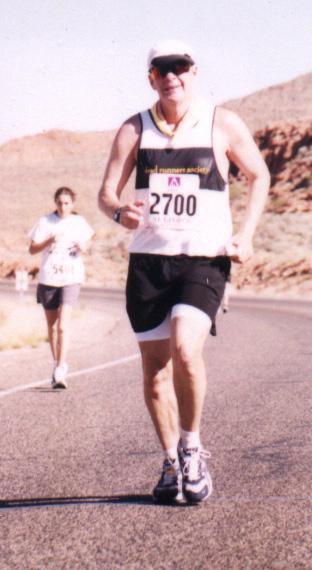
About mile 15,
from photographer's proof
It was now time to stop holding back. Whee! I tore into it, running the next mile in around 9:20, my usual pace for a two- or three-mile run on a good day.
The descent into Snow Canyon begins near mile 17. Whee!! Again I tore into it. Then came more big drops, with another particularly steep one just past mile 22. Anyone who had not trained on hills or who gave all they had before then lost out on an opportunity to pick up some significant time.
I got to 23 miles before deciding I was flying on empty and guts. This was a marked improvement for me. Often I burn out by mile 18. I was tired, and as the elevation got lower and the temperature higher I could feel the strain, but this would be a good finish.
In his clinic Ed Eyestone compared running like a mule to running like a horse. A mule, when tired, will simply stop, and nothing short of a crane can budge it. In contrast, a horse will continue to run until it drops. His point was not to have us all run until we keel over, but simply to run with determination when the going inevitably got tough. So I began to run like a horse, refusing to give in to the urge for walk breaks, knowing that I had very little margin if I wanted to make sub-5:00.
At mile 23 Route 18 enters town and becomes Bluff Street, named for the beautiful high red rock cliff that runs along the whole west side of town, and which is quite visible as the backdrop in finish line pictures. The course is still downhill here. Many people sit out in lawn chairs to cheer the sufferers as they pass. From here on runners are obliged to stay to the left side of the road, allowing traffic to pass freely in both directions.
At 25.3 miles, there is a 120-degree left turn off Bluff, followed immediately by a drop of 6-8 feet in elevation over just 10-15 yards. This puts you on a wide, hard street which I believe is slightly uphill.
This is the finishing stretch from hell. It's by far the toughest 0.9 miles of the race, made all the harder by the increased heat. Some local residents stand in their yards with hoses to spray runners who want it, but to take advantage, one needs to swerve significantly to one side. I didn't bother.
Even though the finish is straight ahead on a nearly flat stretch, for some reason I couldn't see the finish line until the 26-mile pole. The moment I saw it my spirit soared, and I knew I was OK. I even had enough left to save a few good steps for the finishing camera.
When I crossed the finish line I stopped my watch, hoping to be under 5:00. When I looked at it for the first time since the midway split, I roared with laughter. Dig this -- my official chip time was:
Five-colon-zero-zero-colon-zero-zero! Yup, an even 5:00:00, five hours dead flat, and a negative split by a margin of 14 seconds! Actually, my watch said 5:00:01, but the online results show me one second faster. I knew I was within a minute or so either way, but if I had known I was that close, surely I could have squeezed out just a little bit extra to make it 4:59:59. But I'm not complaining, and I consider it a case of having accomplished my time goal.
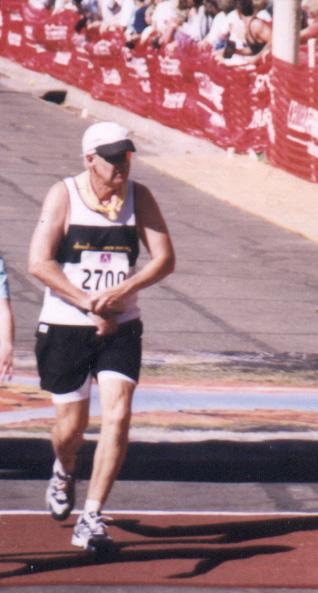
Finish line,
from photographer's proof
At St. George they have a wonderful mist shower in the finish area for exhausted runners. What an excellent provision!
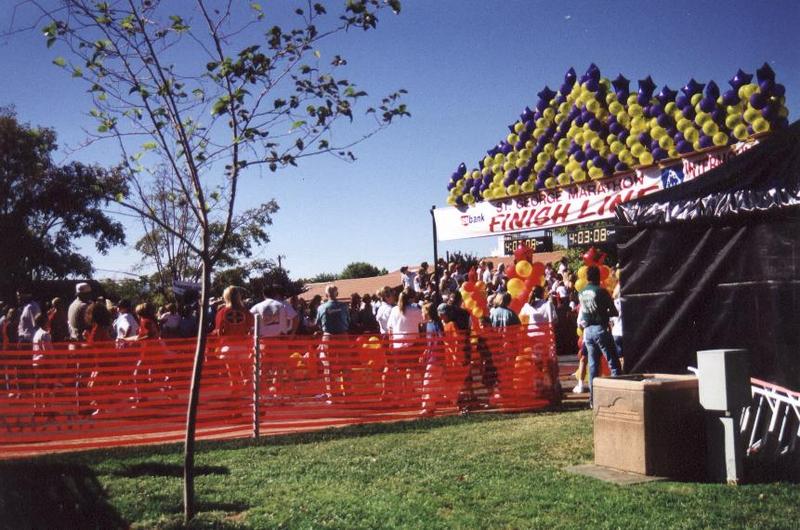
Finish line area,
nearly an hour before I got there
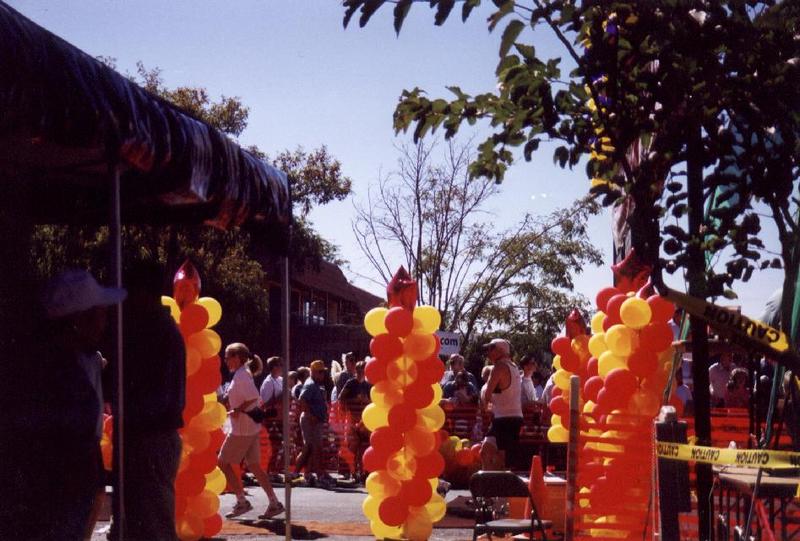
You can almost see the showers from here
Then I was routed through the chip-yanking area, but I said no thank you, it's mine, whereupon I moved on to where a smiling man hung a medal around my neck. It looks just like the one I got in 1997, except for the date. No matter. I hang the useless medals on a wall, and wear out the T-shirts. My lasting memento of each race is the report I write afterward.
The goomies at St. George are good, nourishing, and plentiful: yogurt in abundance, delicious bread with honey butter, and other treats. There is no candy, ice cream and junk food, as I've seen (and consumed ravenously) at other races.
I had drunk plenty on the course, so wasn't thirsty, and also consumed the whole flask of Hammer Gel, which is like drinking Hershey's chocolate syrup. One yogurt and one piece of bread proved to be sufficient food for me for the time being.
Beyond the finishing area there is a large fenced-in area for runners only, in order to assure that it's the runners who get the goodies offered. I strolled the border while spooning in yogurt, but couldn't find Suzy for about ten minutes. She said she managed to get a couple of finishing photos. Five minutes later I lost her again. So I picked up my jacket, stopped at the free massage area and learned there was a three-hour wait, so passed on it, then went to watch more back end finishers. Finally I just crashed on the grass near the awards area. I couldn't really see or hear much of the awards, and at this writing all I know is that some Japanese guy won the men's race, and I still don't know about the women's race.
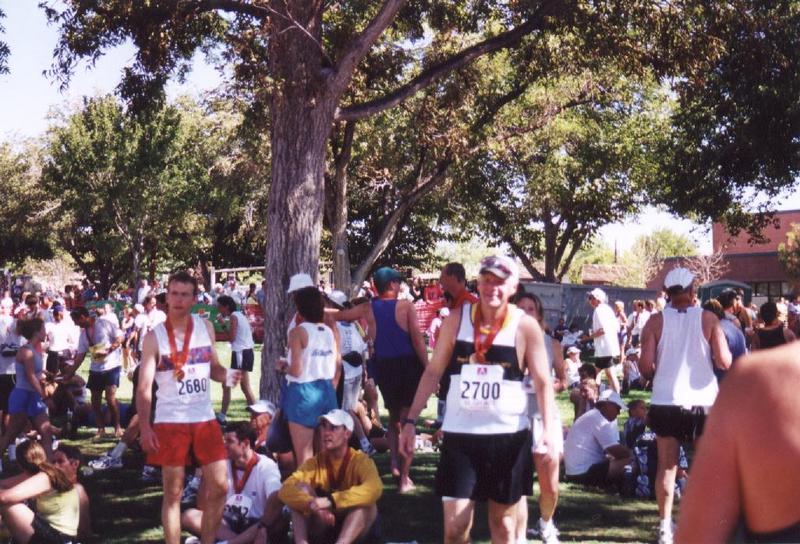
Runners Refreshment Area
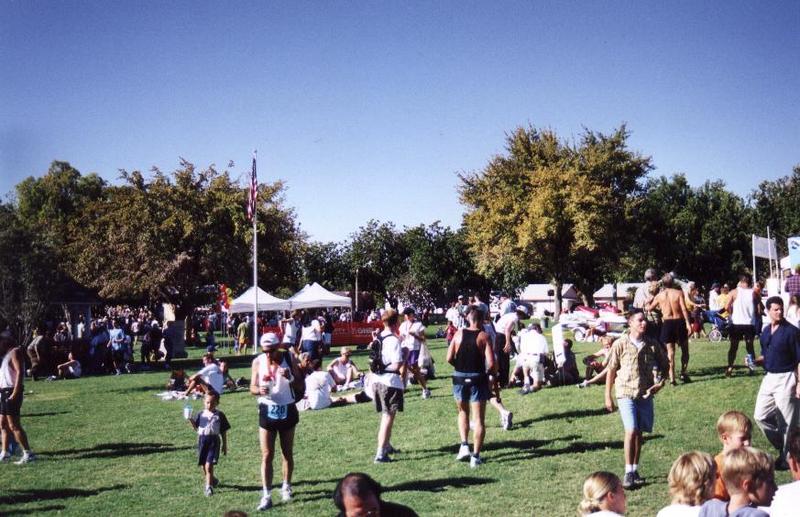
In the park
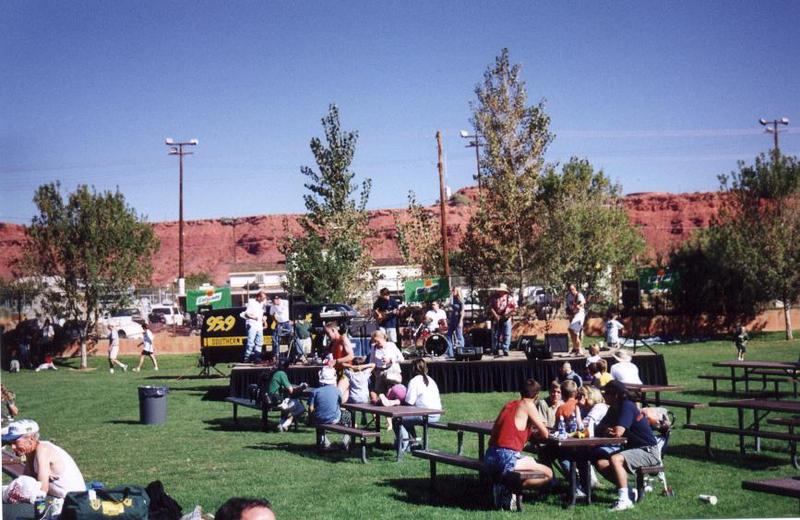
In the park looking west, bluff in background
I've often said that the people in the lead at a marathon run an entirely different event from the mid- to back-of-packers. We are almost as scarcely aware of or concerned with what goes on at the front as they are of five-hour finishers. I'll read all the highlights later when I get time.
I remained sprawled on the grass for what must have been close to an hour. By that time Suzy, who had been off reading somewhere, managed to re-find me.
Just as I was stirring to get up and try moving again, I spotted a fellow Dead Runner from Indiana walking by. We chatted about ten minutes. He had set a 3:15 PR, and was the only Dead Runner I found.
We left the race site at 1:30, while there were still plenty of people around. It took just a couple of minutes to get back to the hotel, and by 2:00 PM I was showered, cool, comfortable, and sitting on the bed in our motel downloading my memories into a notebook. It wasn't long before I drifted off for a comfortable nap of an hour or so, while Suzy engaged in her own favorite sport: shopping!
Physically, I survived the race well. The balls of my feet did not bother me badly, either during the race, or the next couple of days afterward. However, despite the duct tape and Bag Balm precautions, I managed to acquire one blister on each foot, both of them under the tape, and in places I've never had blisters before. Go figure. These did not bother me at all during the race itself, even though I found blood on both socks when I took my shoes off.
As soon as I got up we went off to eat at an Outback steakhouse just around the corner. It's an interesting experience getting served a beer in Utah. The cute teenage girl waitress obviously didn't even know the products, even though there is a bar in the restaurant. These are so rare in Utah, that restaurants with liquor licenses advertise them in the yellow pages.
The next morning we left St. George about 10:00 AM, and were in Las Vegas in less than two hours, where the waitresses are quite familiar with beer, but where I didn't want any. The last time I made that drive it was the other direction, and dark, so it was my first opportunity to see how beautiful it is.
Many persons prefer to remain motionless the day after a marathon, but I've gotten used to them. I was sore, but not unduly so. We got checked into the Stardust quickly, and immediately hit the Strip on foot. We walked up and down it from just after noon until after 4:00 PM, by which time I was really whipped. But I do believe that this exercise probably counted for more than anything in preventing extreme soreness from setting in. I recorded it as five miles of walking in my training log.
The blister on my right pinkytoe, not even noticeable when wearing running shoes, was painful while wearing my Rockports, which my swollen feet could not handle. We dressed to go out to a nice place for dinner and a show, but I really should have just worn running shoes. No one cares what you look like in Las Vegas.
I slept well that night. The next morning, we had breakfast, where I met a man named Don Miller, age 66, wearing a 1991 Twin Cities marathon T-shirt, who had also just run St. George. This regular Boston qualifier from Kansas City is a different class of runner than I am, and had some good tales to tell.
When we finished breakfast we checked out, left right at noon, and took a leisurely and pleasant drive home, with a drive time of almost exactly 6:00, early enough to unpack and enjoy part of the evening.
Marathoning is an eccentric tribal ritual. Thousands of people spend as much as two thousand dollars each on transportation, hotels, fees, and expenses for the privilege of beating themselves up in what is for most little more than a glorified long run in the company of a mass of strangers. In return they carry away a cheap medal, a T-shirt, a place on a listing, maybe a poster, a few memories, and sometimes some pain and disappointment. Then they begin preparing to do it all over again.
So what did I get from this one? Mainly encouragement. Because I went into the race feeling good, rested, and with realistic expectations honed by careful analysis of my training data, I was optimistic. This allowed me to run what was for me, except for the number at the end representing my time, one of the best races I've ever run, because of the negative split, and my ability to follow my race plan in every detail.
My next jaunt will be whatever portion of a 50-mile race I can finish as a training run in nine hours on November 11, followed by Tucson marathon on December 3. It's unlikely that I will get a new PR there as I did in 1997, two months after my first St. George run, but perhaps with careful training and another good day I may be able to get back to 4:45 or 4:50 once again. So that's my next goal.
And your mementos
Will turn to dust
But that's the price you pay
For every year's a souvenir
That slowly fades away
-- Billy Joel